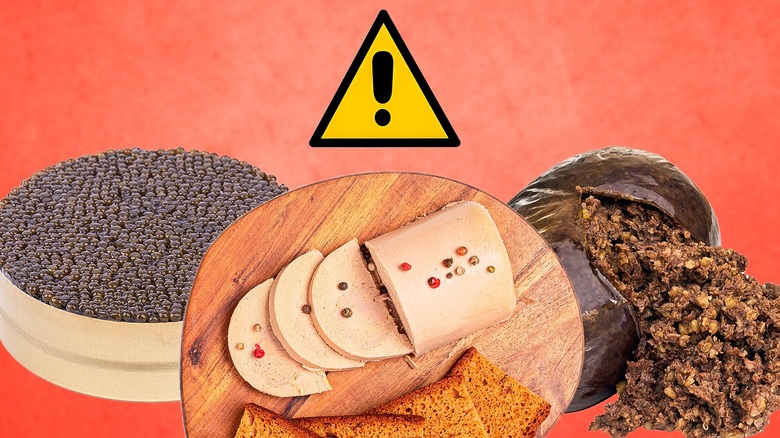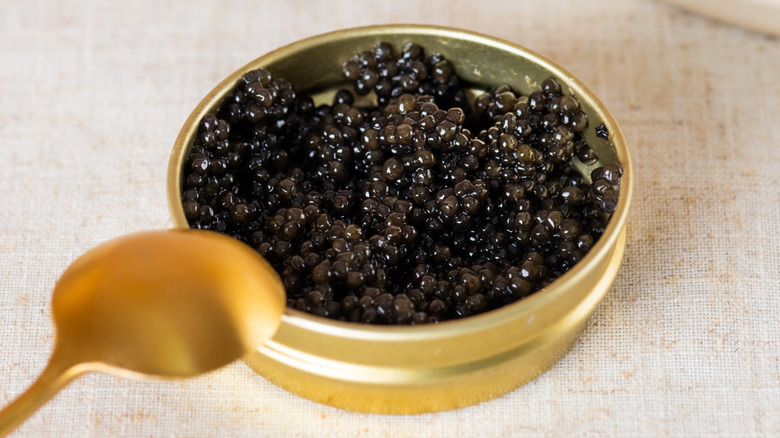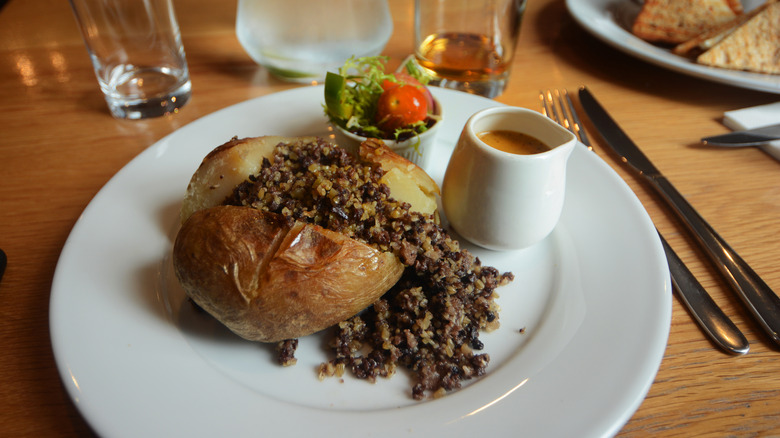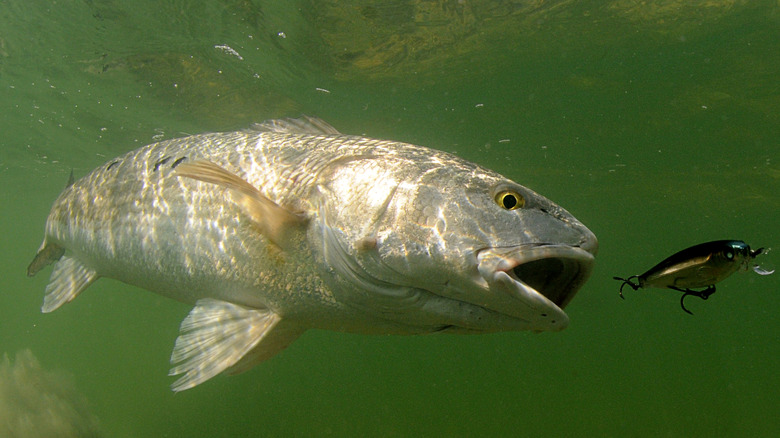Now-Banned Foods That Were Popular In The '70s
Things were pretty different in the 1970s compared to today. There were no mobile phones, no streaming services, and the internet you're reading this on was barely in its infancy. The U.S. would go through the Watergate scandal and the Vietnam War, but also get films like "Star Wars" and see the debut of the first home computer. A time traveler between then and now would hardly recognize their new world, and that includes the food.
It may not seem like food is all that different, but processed foods are far more popular today, and we eat far more grains and fats than they did in the '70s. However, there are also plenty of foods from the 1970s that we don't eat today. In some instances, it's because we realized they were bad for us. Oftentimes, it's because of how they're sourced or due to over-consumption. Let's step back in time and explore some popular '70s foods that are banned today.
Artificial trans fats
Over the last several decades, there has been debate about whether or not fat in foods is healthy. For a while in the '90s and early 2000s, it seemed like every food item had a low-fat or non-fat equivalent. Today, we understand that fat is a key macronutrient that everyone needs. Monounsaturated and polyunsaturated fats are the best for you, while saturated fats should be eaten in moderation, and trans fats should be avoided.
Trans fats primarily come from plant oils that have been chemically changed to become solid fat, also known as partially hydrogenated oils. At one time, these were thought to be a good replacement for trans fats and were used in all sorts of food. Margarine, for example, was touted as a healthy alternative to butter, and the use of margarine peaked in 1976.
However, further study showed that trans fats and partially hydrogenated oils raise levels of "bad" cholesterol and lower levels of "good" cholesterol, which can lead to heart disease. Additionally, it's been linked to diabetes, dementia, and other conditions. In 2015, the Food and Drug Administration (FDA) ruled that artificial trans fats were unsafe to eat and gave food manufacturers three years to completely remove them from their foods.
Beluga caviar
Caviar has long been regarded as a food for the aristocracy, and that's because it's fairly expensive. Caviar consists of the eggs — or roe — of sturgeon. Obtaining caviar requires farming sturgeon — which takes a while — and harvesting the eggs, an intensive process. Add to this that the food is in high demand while the populations of wild sturgeons have decreased drastically, and you have the recipe (no pun intended) for a high-priced, luxury food.
The world's most expensive caviar is beluga caviar, which comes from beluga sturgeon. The only place these fish can be found in the wild is the Caspian Sea, and they're currently endangered. While beluga caviar has been harvested from the Caspian Sea for thousands of years, its popularity exploded in the 1900s.
Beluga caviar was so popular in the '70s and '80s that it led to a massive beluga sturgeon shortage by the 1990s. To help preserve populations, the U.S. banned the import of wild beluga caviar in 2005. Any beluga caviar consumed in the U.S. today must come from caviar farms.
Foie gras
Foie gras is another luxury food, and one that comes with some major animal welfare concerns. On the surface, it doesn't seem worse than any other meat-based dish: it's the liver of duck or goose. However, foie gras is an exceptionally fatty liver, and the way that farmers made this liver fatty is by massively and painfully overfeeding their poultry.
The dish dates back to ancient Egypt, but it was France that made it a cultural delicacy. Traditionally, foie gras was made with duck liver, but in the 1970s, many farms switched to geese instead, as they were considered heartier and more cost-effective. This caused a spike in popularity as foie gras became less expensive and more available to consumers.
The way foie gras is made has raised ethical concerns from animal rights organizations. As a result, various aspects of foie gras manufacturing or trade are illegal in many countries. In the U.S., foie gras is a state-by-state issue. California has banned the sale of foie gras completely, while legislation to ban foie gras is in limbo in New York. Rhode Island has recently introduced legislation that would ban force-fed poultry products, namely foie gras, in the state.
Haggis
Haggis might be the national dish of Scotland, but it doesn't have quite the same love in the U.S. as it does across the pond. The dish is referred to as a savory pudding, but it's more similar to a sausage. Haggis is made of lamb, oats, onions, and spices contained inside an organ-lining casing.
"That doesn't sound terrible," you may be thinking, "So why is haggis banned?" The problem with haggis is that it's partially made from lamb lung. In the 1970s, the U.S. banned the consumption of livestock lungs due to contamination concerns: fluids from the stomach can enter the lungs during slaughter and potentially carry harmful bacteria. Additionally, in 1989, the United States Department of Agriculture (USDA) determined that sheep organs may carry scrapie, a prion disease similar to Mad Cow.
The good news is, haggis as a concept isn't entirely banned -– manufacturers or at-home chefs just need to make it with something other than sheep lungs. However, that means that Scots living in the U.S. can't have their authentic national dish here, and many say the changed recipe just isn't the same.
Red No. 2
Red dye has made headlines recently, as the FDA banned Red No. 3 in early 2025. This ban, which is due to concerns about the dye's ability to cause cancer, is far from the first time red dye has been banned in the U.S., however. One of the first was Red No. 32, banned in 1956 due to research that suggested it could cause organ damage. Not long after, Red No. 1 was banned after the discovery of a link to liver cancer.
One of the biggest red dye food bans happened in 1976 when the FDA banned Red No. 2. At the time, Red No. 2 was one of the most widely-used color additives in the country, consumed by millions in the U.S. every day. It had been used in foods for nearly a century at this point, but studies done in the late '60s and early '70s showed a possible link to cancer. This link has been disputed over the decades, but the ban remains. M&M even stopped manufacturing red M&Ms for a few years, just to avoid scaring customers, even though it had never used Red No. 2.
That same year, Red No. 4 was banned after researchers found that high levels of the dye could damage the adrenal cortex in dogs. Today, the only red dye approved by the FDA is Red No. 40, and even that may go away soon. California already banned this dye in 2024, and the U.S. Department of Health and Human Services (HHS) and FDA are working toward banning all petroleum-based food dyes, which includes Red No. 40.
Redfish
Fish is a common meal option in the U.S., with some of the most popular types being salmon, tuna, and tilapia. If you looked at a seafood menu from the 1970s, you might find redfish on there as well. Redfish, also called red drum, is a fish found in the Atlantic Ocean and the Gulf of Mexico. These fish are usually reddish along the back, which fades into a copper color on the body and into white on the belly. They can get pretty big, up to 61 inches in length.
Redfish became extremely popular in the middle of the 20th century as it's relatively easy to catch and is great for meals, especially in Cajun dishes. However, this popularity caused a steep decline in redfish populations. After major overfishing in the 1970s, Texas worked to protect its populations and started seeing numbers rebound by 1983.
Unfortunately, it wasn't quite enough. Redfish populations elsewhere continued to decline due to commercial overfishing. In 1986, the U.S. government banned commercial redfish fishing in the Gulf of Mexico. Today, it's banned on a state-by-state basis. The only Gulf state that currently allows commercial redfish fishing is Mississippi, and most Gulf states have limits on how many redfish you can catch when fishing recreationally.
Sasafrass
Sassafras is a type of leaf-bearing tree that's native to North America. It was once used by Indigenous peoples in the Americas for cooking and as an herbal remedy. In the 1700s, it was touted as a cure-all in England, and sassafras tea became all the rage.
Sassafras has a fruity, sweet smell, though its oil smells more like cinnamon. The oil comes from the root bark of the sassafras tree, and more recently has been used in soaps and making drinks like root beer. Unfortunately, the roots and bark of sassafras trees, including the oil, have a high concentration of the chemical safrole.
Safrole isn't safe for human consumption. It can cause cancer and liver damage, and high amounts can cause problems like vomiting and hallucinations. Five milliliters of safrole is enough to kill an adult. Sassafras oil was banned for use in foods in the 1960s, but sassafras tea remained popular until it, too, was banned in 1976.
Of course, just because something is banned from being sold doesn't mean people don't still find a way to use it. Some people continue to use it as an herbal remedy for anything from sprains to syphilis to, ironically, cancer. However, sassafras, and sassafras oil in particular, should not be used by children, people who are pregnant or breastfeeding, or people with an upcoming surgery.
Shark fin soup
You can make soup out of just about anything, and in Asia, shark fin soup has been a delicacy for thousands of years. As the name suggests, the main ingredient in shark fin soup is shark fins. To obtain these fins, fishermen will catch the sharks, cut off their fins, and then throw the sharks overboard, where they will eventually bleed out and die.
While the soup was originally a status symbol, it became more popular in the mid-20th century as the Chinese population expanded, its middle class rose, and Chinese immigrants brought their cuisine to America. Shark fin soup became so popular that it started decimating shark populations across the globe, with an estimated 73 million sharks being killed each year for their fins.
By 2022, 13 states in the U.S. had made it illegal for someone to possess, sell, trade, or distribute shark fins. In December of 2022, Congress made the ban nationwide with the Shark Fin Sales Elimination Act. Through this act, it's not technically illegal to make or eat shark fin soup, but it is illegal to sell, own, transport, or purchase shark fins, which makes it pretty difficult to make or eat the soup.
Shark fins are a delicacy, but the practice of "shark finning" has led to a decline in shark populations. While the soup itself is not specifically banned, in 2022, Congress passed the Shark Fin Elimination Act, which bans the sale, possession, transport, and purchase of shark fins.
Unpasteurized milk
Before Louis Pasteur invented pasteurization in 1864, people had no choice but to drink unpasteurized milk. Pasteurization is the process of heating raw milk to kill dangerous germs like salmonella, E. coli, and listeria, all of which can cause food poisoning and even death.
It took a while for pasteurization to become widespread — dairies had to obtain new equipment and shell out a lot of money in order to pasteurize their products. However, by 1911, cities like Chicago and New York had mandated pasteurization, and by the 1920s, pasteurization was relatively standard.
However, standard doesn't mean that everyone does it; even today, there are those who swear that there are health benefits to drinking unpasteurized milk (there aren't). Luckily, major changes in the late '70s and the '80s significantly lowered the popularity of raw milk. First, a newer, faster pasteurization process was implemented. Then, in 1987, the FDA prohibited the interstate sale of raw milk.
Today, raw milk regulation is primarily left up to the state, though it is still illegal to sell raw milk across state lines. Just over a dozen states allow raw milk in stores, while another dozen allow raw milk to be sold at dairy farms. The remaining states prohibit the sale of raw milk to consumers. Unpasteurized milk is not banned nationwide, but on a state-by-state basis. New regulations and pasteurization methods that came about in the '70s reduced the amount of raw milk people drank.
White abalone
Another seafood item that was popular in the '70s but hard to find now is white abalone. White abalone is a type of marine snail, and at one time, there were millions of these guys off the coast of California. They usually live about 80 to 200 feet under the sea and have a thin, oval-shaped shell, very different from the curly shells you might typically imagine a snail to live in.
The problem is, despite their awkward appearance, white abalone are supposed to be pretty tasty. It often offers a flavor blend that's salty, sweet, and buttery. Because white abalone are so delicious, though, they were massively overfished in the 1970s. In addition to having a low reproduction rate and the threat of disease, the population is now in the low thousands. It was listed as endangered under the Endangered Species Act in 2001.
To allow the population to recover, the harvest of white abalone was banned in 1997. Unfortunately, decades later, the population still hasn't recovered, and white abalone are still considered endangered.










